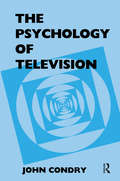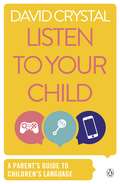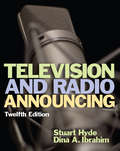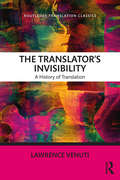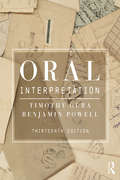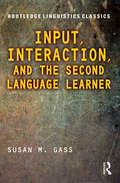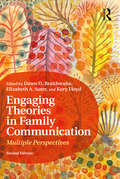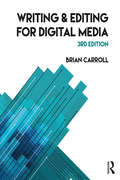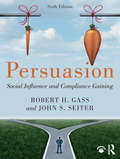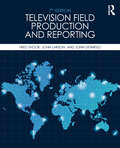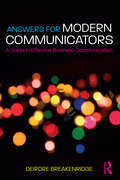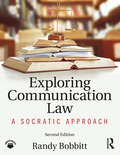- Table View
- List View
Landmark Essays on Rhetoric and Literature: Volume 16
by Craig KallendorfThe studies of rhetoric and literature have been closely connected on the theoretical level ever since antiquity, and many great works of literature were written by men and women who were well versed in rhetoric. It is therefore well worth investigating exactly what these writers knew about rhetoric and how the practice of literary criticism has been enriched through rhetorical knowledge. The essays reprinted here have been arranged chronologically, with two essays selected for each of six major periods: Antiquity, the Middle Ages, the Renaissance (including Shakespeare), the 17th century, the 18th century, and the 19th and 20th centuries. Some are more theoretically oriented, whereas others become exercises in practical criticism. Some cover well-trod ground, whereas others turn to parts of the rhetorical tradition that are often overlooked. Scholars in the field should benefit from having this material collected together and reprinted in one volume, but the essays included here will also be useful to graduate students and advanced undergraduates for course work and general reading. Students of rhetoric seeking to understand how the principles of their field extend into other forms of communication will find this volume of interest, as will students of literature seeking to refine their understanding of the various modes of literary criticism.
The Psychology of Television
by John CondryThis volume addresses the content of television -- both programs and advertisements -- and the psychological effects of the content on the audience. The author not only reports new research, but explains its practical applications without jargon. Issues are discussed and described in terms of psychological mechanisms and causal routes of influence. While primarily referring to the American television industry and American governmental regulations, the psychological principles discussed are applicable to television viewers world wide.
Listen to Your Child: A Parent's Guide to Children's Language
by David CrystalLearning to talk is probably the greatest milestone in a child's development: a deeply moving and often hilarious experience for all parents. In this charming and informative book, Britain's leading expert on the English language talks you through every stage in your child's language development. Over thirty years after its original publication, this new and updated edition of Listen to your Child shows us that while the world our children are growing up in may have changed, one thing has not: parents still need to listen. Gathering decades of research from psychologists and linguists, Professor Crystal shows how the more we know about language acquisition - from 'cooking' and 'babbling' to melodic 'scribble talk' and simple words and then to incessant chatter - the more there is to delight in.From birth to the early school years, Listen to your Child provides a painless introduction to the study of child language acquisition as well as invaluable advice for parents.
Purposeful Communication in a Digital Age: Speaking for Success
by Jason Schmitt Arthur KochIn recent years, the process and outlet for public speaking has grown with digital progressions such as TED talks and Facebook Live. Purposeful Communication in a Digital Age, 2nd Edition, provides a practical, step-by-step approach to developing and delivering effective speeches. Offering supplementary articles, case studies, and interviews with key leaders within the text and online, this is an all-in-one resource for the traditional, online, or hybrid classroom. The new edition devotes focus to presenting in the digital world, addressing both traditional and contemporary forms of presentation, and specifically directs students on seeking out credible sources when conducting research. Its eResource features video speech examples, classroom exercises, an instructor manual, and a quiz bank.
Television and Radio Announcing
by Stuart HydeThe digital revolution has significantly changed broadcast technology. The 12th edition of Television and Radio Announcing reflects new trends in the field, such as the reconfiguration of electronic media production practices and distribution models. The internet and social media have opened up new access to production and new methods of distribution, such as YouTube, Facebook, Twitter, and podcasts. The 12th edition addresses the realities of students who live in this new era. Learning GoalsUpon completing this book, readers will be able to: Develop essential announcing skills Understand new trends in the field
The Translator's Invisibility: A History of Translation (Routledge Translation Classics)
by Lawrence VenutiSince publication over twenty years ago, The Translator’s Invisibility has provoked debate and controversy within the field of translation and become a classic text. Providing a fascinating account of the history of translation from the seventeenth century to the present day, Venuti shows how fluency prevailed over other translation strategies to shape the canon of foreign literatures in English and investigates the cultural consequences of the receptor values which were simultaneously inscribed and masked in foreign texts during this period. Reissued with a new introduction, in which the author provides a clear, detailed account of key concepts and arguments in order to issue a counterblast against simplistic interpretations, The Translator’s Invisibility takes its well-deserved place as part of the Routledge Translation Classics series. This book is essential reading for students of translation studies at all levels.
A Manager's Guide to PR Projects: A Practical Approach
by Patricia ParsonsA Manager's Guide to PR Projects, Second Edition picks up where classic public relations textbooks leave off. It provides hands-on guidance in planning the preliminary research for a public relations project and creating a plan to achieve specific goals, guiding the reader through managing the project's implementation. It contains worksheets that can be used for a visual representation of the planning process for both student edification and presentation to clients. The book is designed as a user-friendly guide to take the reader through the four-step public relations planning process from a number of vantage points. Intended as a learning tool for use in both the class and beyond, this book's approaches are based on real experiences in the management of communications projects designed to meet organizational goals through achieving public relations objectives. This fully revised second edition offers PR students and practitioners new material that includes the following: The impact of social media on each phase of the planning process. Digital approaches to strategic and summative research, message dissemination and public engagement. Strategies to enhance accountability. Ethics considerations in the planning process. Updated print and web-based resources for PR managers.
Behavioral Economics (Routledge Advanced Texts in Economics and Finance)
by Edward CartwrightOver the last few decades behavioral economics has revolutionized the discipline. It has done so by putting the human back into economics, by recognizing that people sometimes make mistakes, care about others and are generally not as cold and calculating as economists have traditionally assumed. The results have been exciting and fascinating, and have fundamentally changed the way we look at economic behavior. This textbook introduces all the key results and insights of behavioral economics to a student audience. Ideas such as mental accounting, prospect theory, present bias, inequality aversion and learning are explained in detail. These ideas are also applied in diverse settings such as auctions, stock market crashes, charitable donations and health care, to show why behavioral economics is crucial to understanding the world around us. Consideration is also given to what makes people happy, and how we can potentially nudge people to be happier. This new edition contains expanded and updated coverage of contract theory, bargaining in the family, time and risk, and stochastic reference points, among other topics, to ensure that readers are kept up to speed with this fast-paced field. The companion website is also updated with a range of new questions and worked examples. This book remains the ideal introduction to behavioral economics for advanced undergraduate and graduate students.
Oral Interpretation
by Timothy Gura Benjamin PowellIn its 13th Edition, the iconic Oral Interpretation continues to prepare students to analyze and perform literature through an accessible, step-by-step process. New selections join classic favorites, and chapters devoted to specific genres—narrative, poetry, group performance, and more—explore the unique challenges of each form. Now tighter and more focused than its predecessors, this edition highlights movements in contemporary culture—especially the contributions of social media to current communication. New writings offer advice and strategies for maximizing body and voice in performance, and enhanced devices guide novices in performance preparation.
Interviewing in a Changing World: Situations and Contexts
by Jonathan H. Amsbary Larry PowellInterviewing in a Changing World offers students the broadest coverage of interviewing available today by including several unique interview situations. Students begin to develop a better understanding of how to utilize strong interviewing skills in several different settings, as this text demonstrates that interviewing techniques differ in accordance with varying situations and contexts. The Second Edition covers employment contexts such as job interviews, persuasive interviews, performance and appraisal interviews, as well as media interviews on radio, television, newspapers, and political reporting. There are two full chapters on research, including interviewing skills needed for both qualitative and quantitative research. The book covers several unique interviewing situations that are on the cutting edge of communication research with an interview with a professional from the field and multiple sidebars on related theoretical and applied issues within each chapter.
The Law of Public Communication
by Kent R. Middleton William E. Lee Daxton R. StewartNow in its tenth edition, The Law of Public Communication provides an overview of media law that includes the most current legal developments. It explains the laws affecting the daily work of writers, broadcasters, PR practitioners, photographers, and other public communicators. By providing statutes and cases in an accessible manner, even to students studying law for the first time, the authors ensure that students will acquire a firm grasp of the legal issues affecting the media. This new edition features color photos, as well as breakout boxes that apply the book’s principles to daily life. The new case studies discussed often reflect new technologies and professional practices.
Input, Interaction, and the Second Language Learner (Routledge Linguistics Classics)
by Susan M. GassTwenty years after its first publication, Susan M. Gass’s Input, Interaction, and the Second Language Learner has become a classical text in the field of second language acquisition (SLA). This new printing includes the original text, along with a new preface that comprises individual consultations between the author and Alison Mackey, Rod Ellis, and Mike Long on the importance of the project two decades later. The volume provides an important view of the relationship between input, interaction, and SLA. In so doing, it should prove useful to those whose major concern is with the acquisition of a second or foreign language, as well as those who are primarily interested in these issues from a pedagogical perspective. The book does not explicate or advocate a particular teaching methodology, but does attempt to lay out some of the underpinnings of what is involved in interaction—what interaction is and what purpose it serves. Research in SLA is concerned with the knowledge that second language learners do and do not acquire, and how that knowledge comes about. This book ties these issues together from three perspectives: the input/interaction framework, information-processing, and learnability. This Routledge Linguistics Classic remains a key text for all SLA scholars and an essential supplementary volume for students on SLA courses.
Strategic Writing: Multimedia Writing for Public Relations, Advertising and More
by Charles Marsh David W. Guth Bonnie Poovey ShortIn its fourth edition, Strategic Writing emphasizes the goal-oriented mission of high-quality public relations and media writing with clear, concise instructions for more than 40 types of documents. This multidisciplinary text covers writing for public relations, advertising, sales and marketing, and business communication. In addition, it includes concise chapters on topics such as diversity, ethics and the legal aspects of strategic writing. Featuring a spiral binding, examples for each document and a user-friendly "recipe" approach, Strategic Writing is ideal for undergraduate PR or advertising writing classes that take an interdisciplinary approach. This new edition devotes new attention throughout to social media and writing in the digital realm, and features new and updated online resources for students and instructors.
Renovating Your Writing: Shaping Ideas and Arguments into Clear, Concise, and Compelling Messages
by Richard KallanRenovating Your Writing outlines the principles of effective composition by focusing on the essential skill set and mindset every successful writer must possess. Now in its second edition, this novel text provides readers with unique strategies for crafting and revising their writing, whether for school, work, or play. The new edition emphasizes, in particular, the importance of the writer embracing a rhetorical perspective, distinguishing between formal and social media compositional styles, and appreciating the effort needed to produce clear, concise, and compelling messages.
Handbook of Instructional Communication: Rhetorical and Relational Perspectives
by Marian L. Houser Angela HosekThe Handbook of Instructional Communication offers a comprehensive collection of theory and research focusing on the role and effects of communication in instructional environments. Now in its Second Edition, the handbook covers an up-to-date array of topics that includes social identity, technology, and civility and dissent. This volume demonstrates how to understand, plan, and conduct instructional communication research as well as consult with scholars across the communication discipline. Designed to address the challenges facing educators in traditional and nontraditional settings, this edition features a wealth of in-text resources, including directions for future research, suggested readings, and surveys for instructional assessment.
Modern Rhetorical Criticism
by Roderick P Hart Suzanne M. Daughton Rebecca LavallyA comprehensive and up-to-date introduction to the analysis of public rhetoric, Modern Rhetorical Criticism teaches readers how to examine and interpret rhetorical situations, ideas, arguments, structure, and style. The text covers a wide range of critical techniques, from cultural and dramatistic analysis to feminist and Marxist approaches. A wealth of original criticism demonstrates how to analyze such diverse forms as junk mail, campaign speeches, and popular entertainment, as well as literature. This long-awaited revision offers specific guidance on crafting analytic essays, and contains new coverage of legacy as well as new media, identity criticism, and post-colonial and decolonial criticism. The fourth edition also offers additional resources online for instructors and students.
Mixed Media: Moral Distinctions in Advertising, Public Relations, and Journalism
by Tom BivinsMixed Media offers students of journalism, advertising, and public relations the tools for making ethical and moral decisions within their professional disciplines. Covering both ethical theory and its practical application to the media professions, Mixed Media serves as an indispensable starting point for those seeking to develop an ethical framework with regard to mass media. Each media industry is covered with specific attention paid to relevant ethical decision-making approaches involving primary concerns such as truth telling, constituent obligations, persuasion versus advocacy, and respect for the consumers of public communication. In addition, the book covers new media and how ethics affect such concepts as social media, word-of-mouth advertising, and the impact of the digital revolution. And, new to this edition, recent concerns in areas such as satire and the dilemma of free speech versus constraint are discussed, as well as the quandry of native advertising in journalism. Readers will come away with a greater appreciation for moral philosophy and theory as a foundation for decision making, and will develop a personal "yardstick" by which to measure their decisions.
Engaging Theories in Family Communication: Multiple Perspectives
by Dawn O. Braithwaite Kory Floyd Elizabeth A. SuterEngaging Theories in Family Communication, Second Edition delves deeply into the key theories in family communication, focusing on theories originating both within the communication discipline and in allied disciplines. Contributors write in their specific areas of expertise, resulting in an exceptional resource for scholars and students alike, who seek to understand theories spanning myriad topics, perspectives, and approaches. Designed for advanced undergraduate and graduate students studying family communication, this text is also relevant for scholars and students of personal relationships, interpersonal communication, and family studies. This second edition includes 16 new theories and an updated study of the state of family communication. Each chapter follows a common pattern for easy comparison between theories.
Writing and Editing for Digital Media
by Brian CarrollWriting and Editing for Digital Media teaches students how to write effectively for digital spaces—whether writing for an app, crafting a story for a website, blogging, or using social media to expand the conversation. The lessons and exercises in each chapter help students build a solid understanding of the ways that digital communication has introduced opportunities for dynamic storytelling and multi-directional communication. With this accessible guide and accompanying website, students learn not only to create content, but also to become careful, creative managers of that content. Updated with contemporary examples and pedagogy, including examples from the 2016 presidential election, and an expanded look at using social media, the third edition broadens its scope, helping digital writers and editors in all fields, including public relations, marketing, and social media management. Based on Brian Carroll's extensive experience teaching a course of the same name, this revised and updated edition pays particular attention to opportunities presented by the growth of social media and mobile media. Chapters aim to: Assist digital communicators in understanding the socially networked, increasingly mobile, always-on, geomapped, personalized media ecosystems; Teach communicators to approach storytelling from a multimedia, multi-modal, interactive perspective; Provide the basic skill sets of the digital writer and editor, skill sets that transfer across all media and most communication and media industries, and to do so in specifically journalistic and public relations contexts; Help communicators to put their audiences first by focusing attention on user experience, user behavior, and engagement with their user bases; Teach best practices in the areas of social media strategy, management, and use.
Persuasion: Social Influence and Compliance Gaining
by Robert H Gass John S SeiterNow in its sixth edition, Persuasion: Social Influence and Compliance Gaining continues to boast an accessible voice and vibrant aesthetic that appeals to undergraduate students of communication, psychology, advertising, and marketing. In addition to presenting established theories and models, this text encourages students to develop and apply general conclusions about persuasion in real-world settings. Along the way, students are introduced to the practice of social influence in an array of contexts (e.g., advertising, marketing, politics, interpersonal relationships, social media, groups) and across a variety of topics (e.g., credibility, personality, deception, motivational appeals, visual persuasion). The new edition features an expanded treatment of digital and social media, up-to-date research on theory and practice, and enhanced discussions of topics such as political campaigning, emotional marketing, olfactory influence, and ethics. Forthcoming: Instructors can also use the book’s downloadable test bank, instructor’s manual, and PowerPoint slides in preparing course material.
Online Journalism: Principles and Practices of News for the Web
by Jim FoustThe third edition of Online Journalism builds on the foundations of journalism to clearly show how they can be integrated into online environments. It takes the perspective that web content shouldn't be a separate component or an afterthought but instead is a vital part of story creation. From doing research to creating the web space, to posting and getting stories into the hands of users, this useful resource gives students the tools they need. Online Journalism readies readers for wherever their news careers take them, whether it's to the online portion of legacy news organizations, to online-only startups, or to blogs, news apps and beyond. Key features include a companion website, practical activities at the end of each chapter, screenshots illustrating key concepts and a Glossary.
Television Field Production and Reporting: A Guide to Visual Storytelling
by Fred Shook John Larson John DeTarsioTelevision Field Production and Reporting provides a comprehensive introduction to the art of video storytelling. Endorsed by the National Press Photographers Association, this book focuses on the many techniques and tools available in today’s digital landscape, including how drones and miniaturized technology can enrich the storytelling process. The new edition of Television Field Production and Reporting is an absolute must in this visually oriented, rapidly changing field. At its core, visual storytelling helps transmit information, expose people to one another, and capture and communicate a sense of experience in unforgettable ways. This edition reflects, through practitioners' eyes, how to achieve those goals and excel as a professional, whatever the medium at hand, even as changing technology revises the storyteller’s toolkit. This edition emphasizes digital and emerging media, and includes new color photography relevant to contemporary visual storytelling and reporting. It also features important updates regarding digital media law which affect anyone who records and/or disseminates digital media content, whether in private, on television, the web, via social networking sites, or in commercial venues. The seventh edition of Television Field Production and Reporting stresses the mastery of innovative storytelling practices in video programming as far ranging as electronic press kits, multi-camera production, stylized programs, corporate video, raw documentaries, and real time cinéma vérité.
Answers for Modern Communicators: A Guide to Effective Business Communication
by Deirdre BreakenridgeThis book provides students and professionals with practical answers to important career and communication questions, helping them to communicate successfully in a business setting. Communication expert, Deirdre Breakenridge, examines the ways in which professionals can make the most of their careers in a fast-changing media landscape, offering advice on how new and seasoned executives can utilize and adapt to the latest modes of communication. The author breaks down the eight most critical areas for professionals seeking to develop their communication skills, opening with essentials that will prove useful in any setting. She then details the ways in which organizations can adapt to changes in technology and consumer behavior to improve relationships, social media presence, and brand recognition. The easy to follow question–answer format walks readers through the most pressing, confusing, and frequently asked questions about successful communication with plenty of advice and examples for a better learning experience. Covering traditional business communication topics like partnerships and storytelling, the book also includes material on digital and social media channels as well as a chapter on giving back as a mentor. "Experts Weigh In" boxes feature advice from other top professionals, exposing the reader to multiple perspectives from the field. Grounded in decades of experience, Answers for Modern Communicators will benefit all students getting ready to enter the workforce as well as professionals looking to enhance their communication skills.
Communication Research Methods in Postmodern Culture: A Revisionist Approach
by Larry Z. LeslieThe second edition of Communication Research Methods in Postmodern Culture continues to explore research from a postmodern perspective. Typical qualitative and quantitative research methods are adjusted to fit the needs of contemporary culture. Each chapter is updated with new information and fresh examples. Included in the second edition is a new chapter on Internet and social media research. The author uses straightforward and easy-to-understand language. Both individual and group projects are among the suggested activities. This book is important for the study of communication in a changing political, social, economic, and technological environment.
Exploring Communication Law: A Socratic Approach
by Randy BobbittExploring Communication Law, Second Edition, provides an overview of the law as it pertains to print, broadcast, and online journalism, as well as non-journalistic forms of expression. It begins by introducing students to the First Amendment in a general sense, then explores how the principles of free speech are applied in various circumstances, such as political speech, sexual expression, and K-12 and college campuses. The text also explains the fundamentals of media law in areas such as defamation, privacy, the media and the courts, confidentiality and privilege, access to information, broadcasting, and cyberspace.

